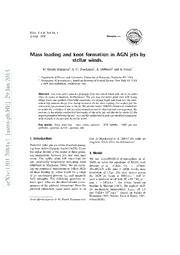
Mass loading and knot formation in AGN jets by stellar winds PDF
Preview Mass loading and knot formation in AGN jets by stellar winds
Mem.S.A.It.Vol.84,1 (cid:13)c SAIt 2008 Memoriedella Mass loading and knot formation in AGN jets by stellar winds. M.Huarte-Espinosa1,E.G.Blackman1,A.Hubbard2 andA.Frank1 3 1 0 1 DepartmentofPhysicsandAstronomy,UniversityofRochester,RochesterNY,USA 2 2 DepartmentofAstrophysics,AmericanMuseumofNaturalHistory,NewYorkNY,USA n e-mail:[email protected] a J 9 Abstract. Jetsfromactivegalaxiespropagatefromthecentralblackholeouttotheradio 2 lobesonscalesofhundredsofkiloparsecs.Thejetsmayencountergiantstarswithstrong stellarwindsandproduceobservablesignatures.Forstrongwindsandweakjets,theinter- ] actionmaytruncatethejetflowduringitstransitviathemassloading.Forweakerjets,the E interactioncanproduceknotsinthejet.Wepresentrecent3DMHDnumericalsimulations H tomodeltheevolutionofthisjet-windinteractionanditsobservationalconsequences.We . explore(i)therelativemechanicalluminosityoftheradiojetsandthestellarwinds(ii)the h impactparameterbetweenthejets’axisandthestellarorbitalpath(iii)therelativemagnetic p fieldstrengthofthejetsandthestellarwinds. - o Key words. Stars: mass-loss – stars: winds, outflows – ISM: bubbles – ISM: jets and r t outflows–galaxies:active–galaxies:jets s a [ 1. Introduction Cen A (Hardcastle et al. 2003)? Do radio jet 1 v magneticfieldsaffecttheinteraction? 1 Powerfulradio jets are often observedemerg- 8 ingfromActiveGalacticNuclei(AGN).Given 0 thestellardensityatthecenterofthesegalax- 2. Model 7 ies, interactions between jets and stars may 1. occur. The stellar wind will mass-load the We use AstroBEAR2.0 (Cunningham et al. 0 jets, potentially temporarily truncating them 2009) to solve the equations of MHD, with 3 (Hubbard & Blackman 2006). We are carry- domain: |x|,|y| ≤2kpc; 0≤ z ≤6kpc; 1 ing out numerical simulations to follow AGN 40×40×120 cells plus 5 AMR levels; max v: jet mass loading by stellar winds for a range resolution of 1.5pc. The star: moves across i of jet mechanical powers, Lj, and magnetic the AGN jet beam at 600kms−1 and in- X field strengths. The following questions re- jects a spherical wind with M˙ =10−4M yr−1 ⊙ r main open: what are the observational conse- and v =200kms−1, for 10kyr, based on a quences of the jet/wind interaction? Does the Maeder & Meynet (1987). We explore AGN jet/wind interaction cause radio knots as in jet mechanical luminosities, L , of 1.5 AGN and 0.024×1045ergs−1 (based on Falcke & Biermann1995;Biretta,Stern &Harris1991, Sendoffprintrequeststo:M.Huarte-Espinosaetal. respectively). 2 Huarte-Espinosa:AGNjetmassloadingbystellarwinds Fig.1.Density[×10−4partcm−3]ofmodelswithandwithoutawind-injectingstar(leftandrightpanels, respectively)forL =24×1042ergs−1. AGN 3. Results This path need not be parallel to the jet flow, thereby distinguishing such knots from those The initial jet structure in Fig. 1 is caused producedbyinstabilitiespropagatingalongthe byflutinginstabilities. Thestarinjectsa wind jet. • For models in which the entire jet vol- for 10kyr (left panel, 10kyr). Mass-loading umeemits,notjusttheedge,theeffectofmass- onto the AGN jet causes a density dip in the loadingcouldbeadarkspot. beam and mixing of jet and stellar wind ma- terial (contours). We see a knot in the jet’s Acknowledgements. Financialsupportforthis projectwas beam,whichlastsforabout30kyrandshould providedbytheSpaceTelescopeScienceInstitutegrantsHST-AR- 11251.01-A and HST-AR-12128.01-A; by the National Science have observational consequences. Synthetic Foundation under award AST-0807363; by the Department of synchrotronemissionmapswillshowwhether EnergyunderawardDE-SC0001063;andbyCornellUniversity grant41843-7012. the mass loading formed knot may be distin- guishedfromjetintrinsicstructure. References 4. Conclusions Hubbard,A.&Blackman,E.G.,2006,MNRAS,371,1717 Hardcastle,M.etal.,2003,ApJ,593,169 Preliminarystudiesshow:Astarwith M˙ = Cunningham,A.etal.,2009,ApJS,182,519 wind 10−4M yr−1whichlasts10kyrisabletocause Maeder,A.,&Meynet,G.1987,A&A,182,243 ⊙ Falcke,H.,&Biermann,P.L.,1995,AAP,293,665 a significant density dip by about 65% on an BirettaJ.A.,SternC.P.,HarrisD.E.,1991,AJ,101,1632 AGN jet with L =2.4×1043ergs−1. • Mass j loadingcausesmixingofjetandstarmaterial. • Knots formed by stars entering the jet will propagate along the path of the stellar orbit.
